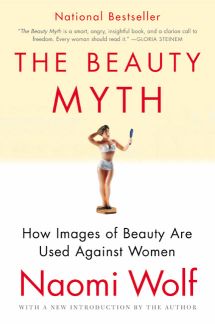If you’re a woman, you can probably relate to these kinds of experiences. If you’re not a woman, ask one who’s close to you about this and she can probably tell you how this same undercurrent has pulled at her throughout her life. But I have hope that if this thing has a name—if it is a man-made construction rather than simply “the way things are” or, worse, “the way God designed things to be”—well, then it’s a system we can climb out of to claim our freedom.
The book explains the myth that our society has constructed: that beauty is a universal, eternal, and unchanging quality, and that possessing it is the only way for women to obtain worth, love, or power in society. Any cross-cultural experience or historical research quickly reveals that standards of beauty are diverse and contradictory throughout time and across the globe. While I grew up always trying to get a tan in the summer, my Chinese friends were horrified at the idea of ruining pale skin with sunlight, and while women in the U.S. diet to stay slim, my Indian friends tell me I’m too skinny and encourage me to get “nice and fat.” Think of foot binding and corsets and all the other strange things women have done over the centuries in pursuit of “beauty”. Nonetheless, the current beauty myth has been retold with such an alloy of fervor and monotony in advertisements, literature, film, popular culture, and even scientific journals that it has convinced most women, either consciously or unconsciously, that their worth lies in their sex appeal. With that in mind, women are essentially doomed to an endless treadmill of buying products and disciplining their bodies as they strive toward an ideal of “beauty” which, with the advent of photoshop, airbrushing, and mass media, is based less on the human form than on the humanoid creations of advertisers and pornographers.
The belief system inspired by the myth explains why, despite the fact that women are more educated, enjoy better health, and have more legal rights, professional opportunities, and influence in wider society than at any other time in history, we’re in a worse state than any previous generation of women “in terms of how we feel about ourselves physically.” Writing in the early ‘90s (and all of these trends have surely intensified since then), Wolf points out that over the last few years, “eating disorders rose exponentially… cosmetic surgery became the fastest-growing medical specialty… pornography became the main media category, ahead of legitimate films and records combined, and thirty-three thousand American women told researchers they would rather lose ten to fifteen pounds than achieve any other goal.”
Wolf maintains that this unrealistic ideal and the unhealthy lengths women go to in order to achieve it have not come about accidentally. This situation has been invented—by advertisers, among others—in order to keep women more concerned with maintaining their appearance than with bringing the full power of their energy and intellect to bear on the world. Who knows what kind of upheaval might result in society from women collectively unleashing their full talents for the first time, after centuries of restrictive roles and separate spheres that have prevented them from participating fully in human history?
The beauty myth creates a caste system which offers social rewards sporadically and temporarily, but playing by its rules, even the most beautiful woman ultimately loses (it’s no coincidence that to be a model, an eating disorder is basically a prerequisite). Whatever fleeting admiration she gains through the system feels like love, but it blocks the real thing by never allowing a woman’s true self to be recognized and loved for who she is. And eventually she will grow older, the lines and marks of lived experience on her body disqualifying her for “beauty” and taking away all her power and worth in society. Wolf suggests that the way out of this mess is not to scramble towards the top of the heap, but to refuse to be locked inside of a caste system at all.
How have we bought into this lie and perpetuated its power in our own lives and the lives of others? What does it look like to break free and to help others do the same?
Source: New feed



